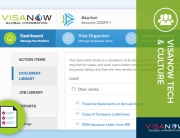The C visa or U.S. transit visa is an extremely short-term visa for individuals passing through the United States in immediate and continuous transit. Generally, Like B visas, C visas are not necessary for citizens of member countries of the Visa Waiver Program. Each person traveling regardless of age needs their own C visa. The maximum duration of any C visa is no more than 29 days.
Who needs to apply for a C Visa?
 Most commonly, travelers and passengers who pass through the U.S. in transit apply for the C visa. Longer stays require the B visa. If a traveler already has a valid B visa, they need not apply for a C visa for their trip. If the traveler is arriving in the U.S. as a crewmember of a ship or airplane, they would need a separate type of visa.
Most commonly, travelers and passengers who pass through the U.S. in transit apply for the C visa. Longer stays require the B visa. If a traveler already has a valid B visa, they need not apply for a C visa for their trip. If the traveler is arriving in the U.S. as a crewmember of a ship or airplane, they would need a separate type of visa.
Some good examples of people who use C visas:
- Travelers who must transfer between separate U.S. airports to reach their ultimate destination
- Cruise ship passengers on ships that briefly stop in the United States but aren’t landing there
- A foreign citizen who would like to leave a U.S. airport during a layover for extremely brief tourist or personal matters (though if it is longer than a few hours, we recommend getting the B-2 travel visa)
Categories of C visas
C-1 visas are for the general traveler population, while C-2 visas are intended for those traveling to the United Nations headquarters on official work. C-3 visas are intended for foreign officials passing in transit through the U.S. There is also a special combination crew/transit visa called the C-1/D visa for crew members passing in transit through the U.S.
C Visa application process and requirements
To apply for the C visa, you must fill out and submit the DS-160 form and set up an interview at your local consulate. As we’ve stated before, processing times and procedures vary from consulate to consulate, so do your research and be prepared when applying for a C visa.
Each week, we look at a different non-immigrant visa by letter, starting with “A” visas. Our intention is to not only help people understand the depth and complexity of U.S. immigration, but also to bring awareness to the enormously diverse pool of immigrants that enter our country every year.







